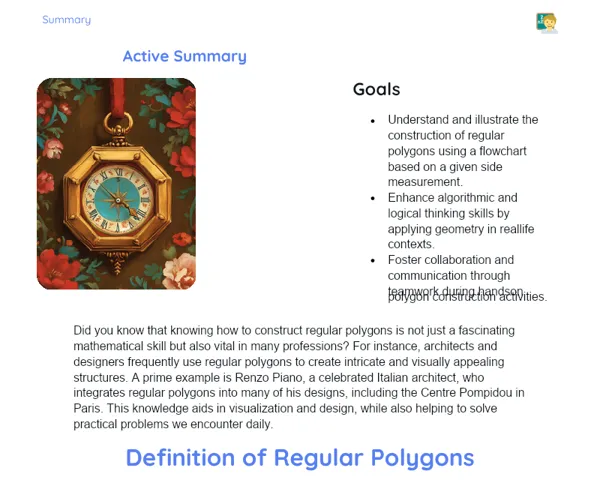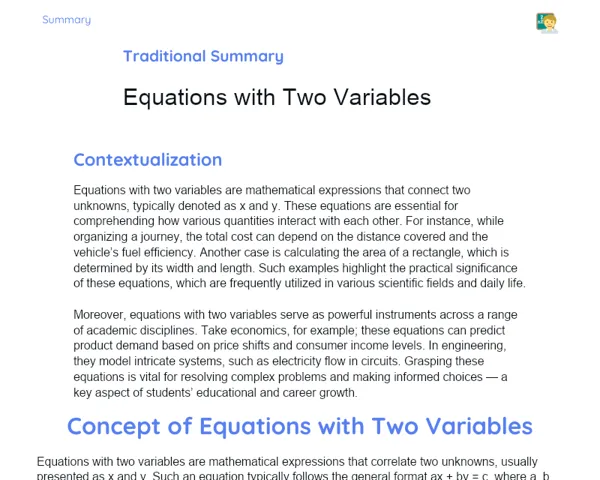Summary Tradisional | Counting Natural Numbers Less Than 1,000
Contextualization
Natural numbers are those we commonly use in our daily lives to count various items, be it people, fruits, or anything else. They start from the number 1 and go on infinitely, but today we'll focus on counting natural numbers that are less than 1,000. This means we will learn how to organize and identify numbers sequentially from 1 to 999. This skill serves as a foundation for various activities, from counting toys to tackling more complex mathematical problems.
Understanding how to count natural numbers below 1,000 will provide us with a strong base in mathematics. In our everyday routines, we rely on these numbers for simple tasks, such as counting the students in a classroom or tallying up fruits in a basket. Moreover, mastering the skill of counting is crucial for grasping more advanced mathematical concepts in the future. By learning to count in an organized way, you are equipping yourself for a range of activities that require accuracy and careful attention.
To Remember!
Counting Natural Numbers from 1 to 100
Counting natural numbers from 1 to 100 forms the basis of understanding the number sequence. This initial stretch is very important as it lays the groundwork for the first numbers we learn to count. The numbers from 1 to 100 are often used in simple daily chores, such as counting toys, fruits, or even the number of pages in a book.
To count from 1 to 100, it’s essential to note that each number is an increment of 1 from the last one. For instance, after 1 comes 2, then 3, and so on, all the way up to 100. This linear progression helps us to appreciate how numbers follow one another.
Practicing counting from 1 to 100 can be done in various engaging ways, such as using number charts, visuals, or simply counting aloud. These activities will strengthen your grasp of the number sequence and hone your counting skills, which are vital for tackling more complex tasks down the line.
-
The journey from 1 to 100 is the cornerstone of numerical comprehension.
-
Each number is formed by adding just 1 to the one before it.
-
Using number charts and active counting sessions aids in practice.
Counting Natural Numbers from 101 to 500
Once you've got the hang of counting from 1 to 100, the next step is to count from 101 to 500. This range includes larger numbers that require a deeper understanding of the structure of natural numbers. Counting from 101 to 500 is key to mastering the handling of larger and more complicated numbers.
A significant characteristic of this range is the change in the digits of hundreds and tens. For example, shifting from 199 to 200 marks a notable change in the number structure that requires attention to detail. Understanding how numbers are arranged in groups of hundreds, tens, and units is vital for accurate counting.
Using diagrams, charts, and hands-on exercises can enhance the learning of these numbers. It's also helpful to practice counting in varied contexts, such as counting larger groups of objects or solving math problems that involve numbers in this range.
-
Counting from 101 to 500 involves larger and more intricate numbers.
-
Shifts in the digits of hundreds and tens are key features in this range.
-
Diagrams, charts, and practical exercises make things easier to understand.
Counting Natural Numbers from 501 to 999
Counting natural numbers from 501 to 999 signifies the final step before reaching the significant milestone of 1,000. This range of numbers includes longer and more complex sequences, requiring a diligent understanding of numerical patterns and regularities. Counting from 501 to 999 helps cement your ability to manage large sets of numbers.
In this section, observing patterns within the digits of hundreds, tens, and units is crucial. For instance, moving from 599 to 600 represents a significant transition that needs to be grasped. Recognizing these patterns streamlines counting and helps avoid common errors.
To practice counting from 501 to 999, one can engage in solving complex math problems, utilising advanced diagrams, and counting larger quantities of objects. These activities serve to deepen the understanding of numbers and enhance efficient counting.
-
Counting from 501 to 999 is the last phase before reaching 1,000.
-
Recognition of patterns in hundreds, tens, and units is essential.
-
Challenging exercises and working with bulk items strengthen practice.
Identifying Quantity in Sets with Fewer Than 1,000 Elements
Beyond counting numbers sequentially, it is also vital to be adept at identifying the number of elements in sets holding fewer than 1,000 items. This skill is instrumental in making quick estimates and confirmations during our daily lives, such as figuring out the number of students in a class or the total books on a shelf.
To determine the quantity of elements in a set, one must either count each item individually or utilise grouping strategies. For instance, organizing items into bundles of ten or hundred can simplify counting and offer a swift estimate. This approach proves useful when quick assessments are needed without the luxury of time.
Practicing this skill can unfold in hands-on activities, like counting classroom objects, inventorying school supplies, or tackling problems that involve large quantities. These tasks help sharpen one’s precision and efficiency in counting and identifying quantities.
-
Identifying quantity in sets is key for making estimates and checks.
-
Using grouping techniques, like tens and hundreds, makes counting simpler.
-
Practical exercises develop both precision and efficiency in counting.
Key Terms
-
Natural numbers: These are numbers used for counting, beginning at 1 and extending to infinity.
-
Number sequence: The linear arrangement of natural numbers, where each number is formed by adding one to the previous one.
-
Numerical ranges: Specific ranges of numbers within a sequence, such as from 1 to 100 or from 501 to 999.
-
Grouping: A method of organizing items into smaller collections to ease counting and estimating.
Important Conclusions
In this lesson, we focused on counting natural numbers that are less than 1,000, breaking down the subject into three key segments: from 1 to 100, from 101 to 500, and from 501 to 999. Each part was approached with practical examples and exercises, aimed at reinforcing the students' grasp of the number sequence and the makeup of natural numbers.
We emphasized the significance of recognizing how numbers are organized into hundreds, tens, and units, alongside the use of charts and graphs to facilitate counting. The ability to identify the quantity of items in sets containing fewer than 1,000 elements was reiterated as a fundamental skill for everyday tasks and more sophisticated mathematical challenges.
We underscored that mastering how to count up to 1,000 is foundational for developing essential mathematical abilities applicable in various day-to-day scenarios. We encourage students to persist with their counting practice and delve deeper into the topic to fortify their understanding.
Study Tips
-
Engage in daily practice of counting natural numbers using charts and graphs to visualize the sequence.
-
Participate in hands-on activities, like counting objects at home or in school, to apply what you've learned.
-
Tackle mathematical challenges that involve numerical ranges and identifying quantities in sets to sharpen counting skills.



